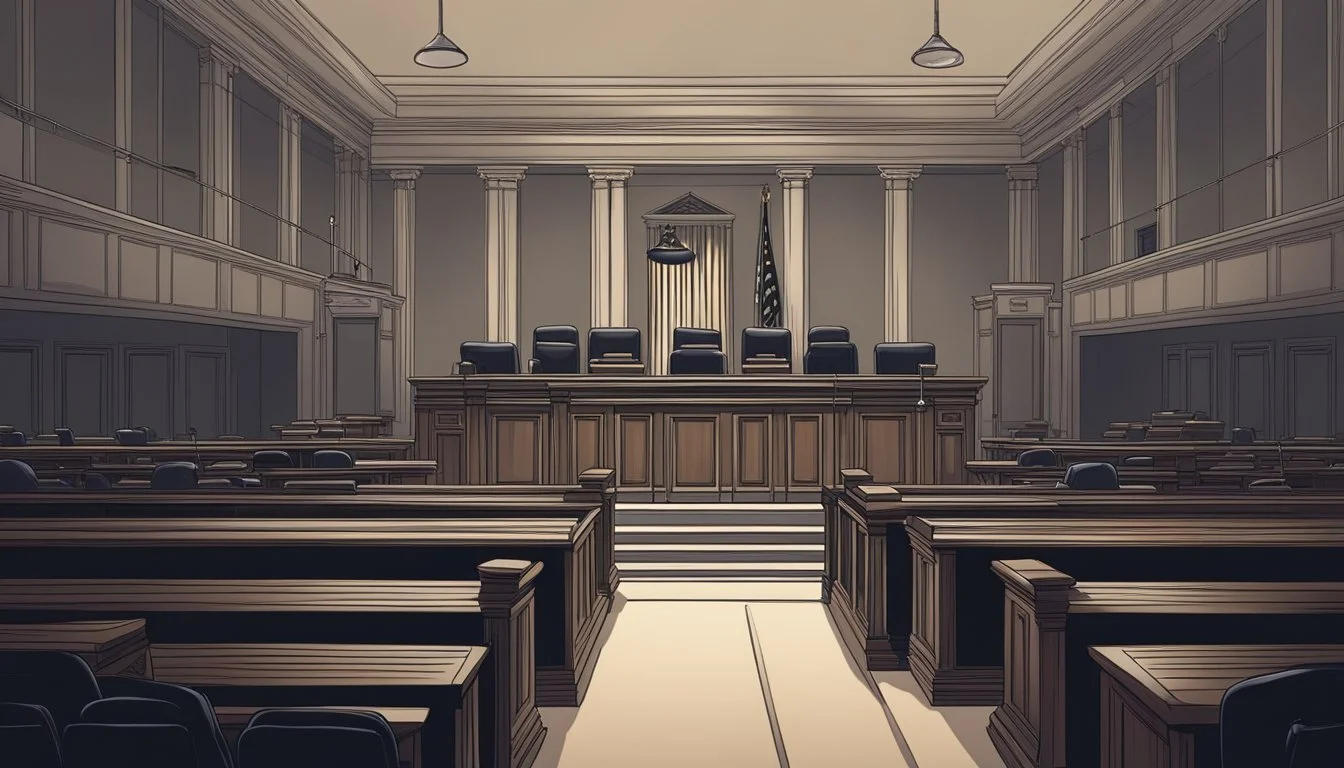Sunshine State Serial Killer: William Darrell Lindsey's Florida Nightmare Unveiled
William Darrell Lindsey terrorized Florida communities during the 1980s and 1990s, earning the moniker "Sunshine State Serial Killer." His reign of terror left a trail of devastation across the state, with victims found in various locations.
Lindsey confessed to murdering at least six women in St. Augustine, Florida, and one in Asheville, North Carolina, between 1983 and 1996. Law enforcement suspected his involvement in up to twenty killings across four southern states. The serial killer's actions shattered the sense of safety in the typically idyllic Florida towns he targeted.
Lindsey's capture in 1996 brought relief to residents and closure to families of his victims. His case serves as a chilling reminder of the dark undercurrents that can exist even in seemingly peaceful communities. The story of the Sunshine State Serial Killer continues to captivate true crime enthusiasts and stands as a stark chapter in Florida's criminal history.
Profile of William Darrell Lindsey
William Darrell Lindsey was a notorious American serial killer who operated in Florida and North Carolina during the 1980s and 1990s. He gained infamy for his brutal crimes and evasion of law enforcement for over a decade.
Early Life and Background
William Darrell Lindsey was born on May 18, 1935, in St. Augustine, Florida. His early life was marked by tragedy. At just five months old, Lindsey lost both his parents in a car accident.
The Lindsay family, who had recently lost their infant child, adopted William. This sudden change in his family structure likely had a significant impact on his upbringing.
Little is known about Lindsey's childhood and teenage years. The lack of information about this period makes it difficult to pinpoint specific events or influences that may have shaped his later criminal behavior.
Known Aliases and Nicknames
William Darrell Lindsey was known by several names throughout his life. His most infamous nickname was "Crazy Bill," which he acquired during his criminal career.
The origin of this moniker is unclear, but it may have been related to his erratic behavior or the brutal nature of his crimes. Some sources also refer to him as "Red Bird," though the significance of this nickname is not well-documented.
Lindsey's use of aliases likely helped him evade capture for many years. By adopting different identities, he was able to move between states and continue his criminal activities undetected.
Timeline of Crimes
William Darrell Lindsey's killing spree spanned over a decade, leaving a trail of victims across Florida. His crimes primarily targeted vulnerable women, with many bodies discovered in St. Augustine waterways.
First Documented Offenses
Lindsey's first known murder occurred in 1983. He killed Lashawna Streeter, a 18-year-old woman from St. Augustine. Her body was found in a creek near Masters Farm.
In 1985, Lindsey struck again. He murdered Debbie Roach, another young woman from the area. Her remains were discovered in a similar waterway.
These initial crimes established Lindsey's pattern of targeting vulnerable women and disposing of bodies in local creeks.
Climax of Criminal Activity
Lindsey's murders escalated in the early 1990s. He killed at least four women between 1991 and 1993:
Cheryl Lucas (1991)
Diana Richardson (1992)
Donetha Snead (1993)
Jackie Habron (1993)
Most victims were found in waterways near West King Street in St. Augustine. Lindsey primarily targeted prostitutes and women struggling with addiction.
End of the Killing Spree
Lindsey's final known murder took place in 1996. He killed Leigh Crutchley in Asheville, North Carolina. This crime led to his capture.
On December 29, 1996, police arrested Lindsey in Asheville. During interrogations, he confessed to multiple murders in Florida and North Carolina.
Lindsey pleaded guilty to six murders in Florida. He received a 30-year sentence in 1999. His reign of terror ended in prison, where he died on April 17, 2001.
Investigation Breakthroughs
The investigation into William Darrell Lindsey's crimes gained momentum through key evidence, witness testimonies, and coordinated efforts by law enforcement agencies. These elements played crucial roles in uncovering the extent of Lindsey's crimes and ultimately leading to his arrest.
Key Evidence
DNA analysis proved instrumental in linking Lindsey to multiple crime scenes. Forensic experts matched his DNA to evidence found on several victims' bodies. This breakthrough allowed investigators to connect previously unrelated cases.
Investigators also discovered clothing items belonging to victims in Lindsey's possession. These items provided tangible links between the suspect and the crimes.
The St. Johns County Sheriff's Office meticulously cataloged physical evidence from crime scenes. This included fibers, hair samples, and other trace materials that would later prove crucial in building the case against Lindsey.
Witness Testimonies
Eyewitness accounts played a vital role in the investigation. Several witnesses reported seeing Lindsey with victims shortly before their disappearances. These testimonies helped establish a timeline of events and placed Lindsey at key locations.
Some witnesses described Lindsey's distinctive vehicle, which matched descriptions given by survivors who had managed to escape his attacks. This information aided law enforcement in tracking Lindsey's movements.
Former acquaintances of Lindsey came forward with information about his suspicious behavior and incriminating statements he had made over the years. These accounts provided valuable context for investigators.
Law Enforcement Agencies' Coordination
The investigation involved collaboration between multiple agencies. The St. Johns County Sheriff's Office worked closely with neighboring jurisdictions to share information and resources.
The Florida Department of Law Enforcement provided crucial support, offering advanced forensic capabilities and additional manpower. This collaboration allowed for a more comprehensive investigation across county lines.
Federal agencies, including the FBI, assisted in tracking Lindsey's movements across state lines. This coordinated effort was essential in piecing together the full extent of his crimes in Florida and North Carolina.
Regular task force meetings ensured all agencies were aligned in their efforts. This unified approach ultimately led to Lindsey's arrest in Asheville, North Carolina, in December 1996.
Victims and Survivor Stories
William Darrell Lindsey's crimes left a devastating impact on numerous families and communities. His victims included women from various backgrounds, each with their own story tragically cut short.
Remembering the Lost
Diana Richardson, 38, disappeared in 1988. Her remains were found in 1992. Lucy Raymer, 75, was killed in Asheville, North Carolina in 1996. Lisa Foley, 26, vanished in 1994. Her body was discovered in 1998.
Cheryl Lucas, 32, went missing in 1993. Donetha Laverne Snead, 24, disappeared in 1994. Anita McQuaig, 22, was last seen in 1991. LaShawna Streeter, 17, vanished in 1994.
Each woman had hopes, dreams, and loved ones left behind. Their lives were senselessly taken by Lindsey's actions.
Impact on Families
The victims' families endured years of anguish and uncertainty. Many searched tirelessly for their missing loved ones, holding onto hope for answers.
When Lindsey was finally caught, it brought a mix of relief and renewed grief. Families could finally lay their loved ones to rest, but also had to face the horrific truth of what happened.
Some relatives spoke at Lindsey's sentencing, sharing memories of the victims and expressing their pain. The loss left children without mothers and parents without daughters.
Support groups formed to help families cope with their shared trauma. Many advocated for improved missing persons investigations to prevent future tragedies.
Legal Proceedings and Convictions
William Darrell Lindsey faced multiple trials and legal proceedings for his crimes across Florida and North Carolina. His case involved complex sentencing considerations and post-conviction developments.
Trials and Sentencing
Lindsey's legal journey began in 1996 when he was arrested in Asheville, North Carolina for the murder of Lucy Raymer. Prosecutors charged him with second-degree murder. In Florida, authorities linked him to six additional killings.
To avoid the death penalty, Lindsey agreed to a plea deal in 1999. He pleaded guilty to six murders in Florida and received a 30-year prison sentence. The deal spared victims' families from enduring lengthy trials.
In North Carolina, Lindsey was convicted of Raymer's murder. The court sentenced him to life in prison without parole for this crime.
Appeals and Post-Conviction
Despite his guilty pleas, Lindsey attempted to appeal his convictions. His lawyers argued ineffective assistance of counsel. However, courts rejected these appeals, upholding the original sentences.
Lindsey's time in prison was short-lived. On April 17, 2001, he died while incarcerated at the age of 65. His death marked the end of legal proceedings against him.
Some investigators believe Lindsey may have been responsible for up to 20 murders across southern states. However, he was never formally charged with additional crimes beyond the seven confirmed victims.
Psychological and Societal Aspects
William Darrell Lindsey's crimes deeply impacted St. Augustine and shed light on the complex psychology behind serial killers. His actions exposed vulnerabilities in the community and left lasting scars.
Motive and Psychopathology
Lindsey targeted prostitutes and drug users, groups often marginalized by society. This choice of victims suggests a desire for power and control over vulnerable individuals. Experts believe Lindsey may have suffered from antisocial personality disorder, characterized by a lack of empathy and disregard for others' rights.
His childhood experiences, including a car accident at 5 months old, may have contributed to his later criminal behavior. Substance abuse likely played a role in lowering Lindsey's inhibitions and fueling his violent tendencies.
Lindsey's ability to maintain a seemingly normal family life while committing heinous crimes points to a split personality typical of some serial killers.
Effects on St. Augustine Community
The revelation of a serial killer in St. Augustine shattered the city's sense of safety. Residents, especially women involved in sex work, lived in fear during Lindsey's active years.
Local law enforcement faced criticism for not connecting the murders sooner. This led to improved investigative techniques and increased cooperation between agencies.
The crimes highlighted the dangers faced by sex workers and drug users, prompting discussions about social services and support for at-risk populations.
St. Augustine's tourism industry temporarily suffered as the city gained notoriety for the killings. Community leaders worked to restore the city's reputation while addressing the underlying issues exposed by Lindsey's crimes.
Media Depictions and Legacy
William Darrell Lindsey's crimes have been featured in various true crime media. His case has left a lasting impact on public perception of serial killers in Florida.
True Crime Renditions
Investigation Discovery's "Evil Lives Here" featured Lindsey's case in an episode titled "I Hate Being Daddy's Girl." The show explored the perspective of his daughter, Robin Lindsey, providing insight into the killer's family life. Print media also covered Lindsey's crimes extensively, with local Florida newspapers reporting on the investigations and trials.
Several true crime books have included chapters on Lindsey, detailing his murders and the subsequent legal proceedings. These works often highlight the challenges faced by law enforcement in connecting the various cases across different jurisdictions.
Public Perception and Impact
Lindsey's crimes shocked the communities of St. Augustine and Asheville. His targeting of vulnerable women, particularly those involved in sex work, raised awareness about the risks faced by marginalized groups.
The case influenced public discourse on safety in Florida's tourist areas. Local authorities implemented new measures to protect potential victims and improve communication between police departments.
Lindsey's legacy as the "Sunshine State Serial Killer" continues to be a cautionary tale. His crimes serve as a reminder of the importance of vigilance and the need for robust support systems for at-risk individuals in society.
William Darrell Lindsey's Life after Conviction
William Darrell Lindsey's post-conviction life was marked by confinement and declining health. His time in prison was characterized by limited contact with the outside world and a battle with cancer.
Incarceration and Health
Lindsey served his 30-year sentence in a Florida state prison. The harsh prison environment took a toll on his physical well-being. He developed cancer during his incarceration, which significantly impacted his health.
Lindsey's prison routine consisted of limited activities and strict schedules. His cancer diagnosis led to frequent medical treatments within the prison system. The disease progressed rapidly, affecting his daily life in custody.
Contacts with the Outside World
Lindsey's communication with family members, including his daughter Robin Lindsey, was restricted. Prison regulations limited his visitation rights and phone calls. He maintained sporadic contact through letters and occasional supervised visits.
Robin Lindsey struggled with her father's crimes and incarceration. Their relationship was strained, with infrequent interactions. Lindsey's criminal past affected his family's willingness to maintain close ties.
The prison's policies on inmate communication shaped Lindsey's connections to the outside world. His ability to stay informed about events beyond prison walls was limited by these restrictions.
The Aftermath
The aftermath of William Darrell Lindsey's crimes left a lasting impact on law enforcement and the communities affected. His actions prompted changes in investigative approaches and sparked efforts to honor the victims.
Law Enforcement Reflections
Florida law enforcement agencies conducted thorough reviews of their procedures following Lindsey's case. They identified gaps in communication between jurisdictions that had allowed his crimes to go undetected for years. As a result, new protocols were implemented for sharing information about missing persons and potential serial killers across county lines.
Detectives involved in the case emphasized the importance of preserving DNA evidence, even in seemingly unrelated crimes. This lesson proved crucial in eventually linking Lindsey to multiple murders. The case also highlighted the value of cold case units, as some of Lindsey's victims had initially been classified as endangered missing persons.
Community Healing and Memory
St. Augustine residents grappled with the reality that a serial killer had lived among them undetected. Support groups formed for families of victims and those affected by the crimes. These groups provided a space for healing and advocated for improved safety measures in the community.
Local officials dedicated a memorial garden to honor Lindsey's victims. The garden serves as a place of reflection and remembrance. Annual vigils are held to ensure the victims are not forgotten and to raise awareness about violence against women.
Schools and community centers developed educational programs focused on personal safety and the importance of reporting suspicious behavior. These initiatives aimed to empower residents and prevent future tragedies.










